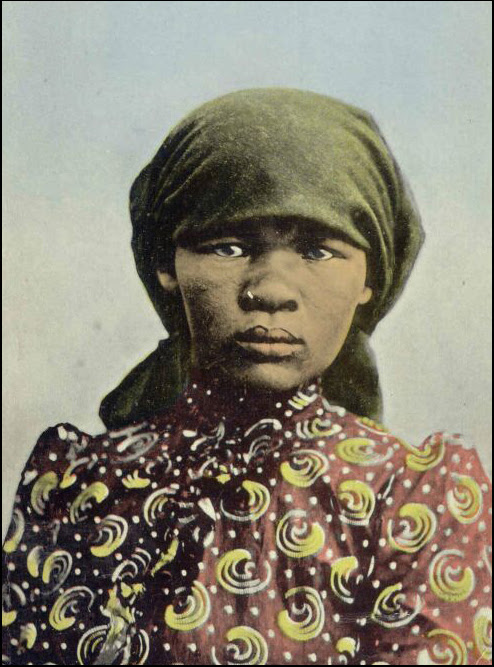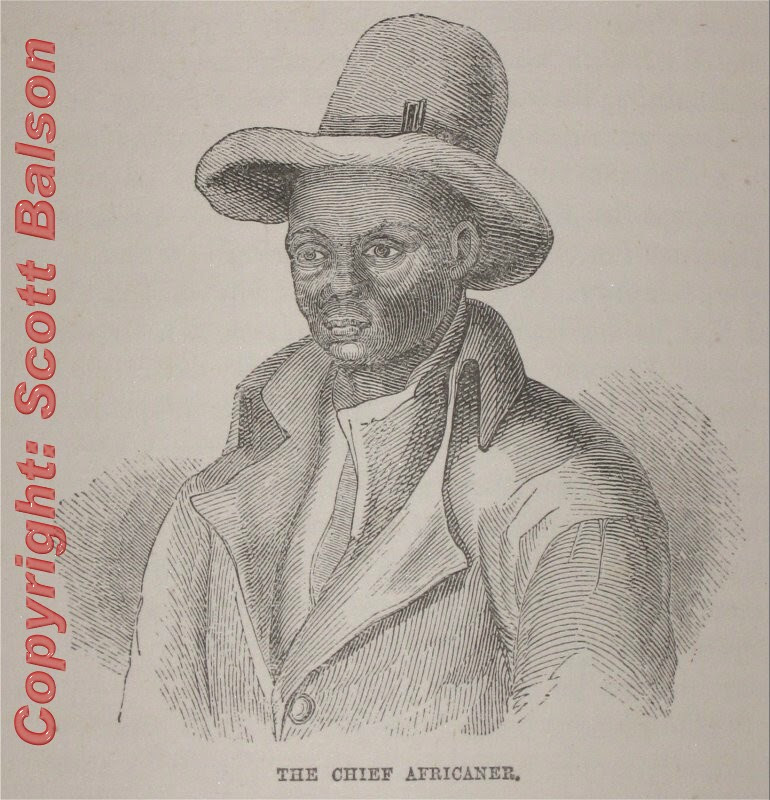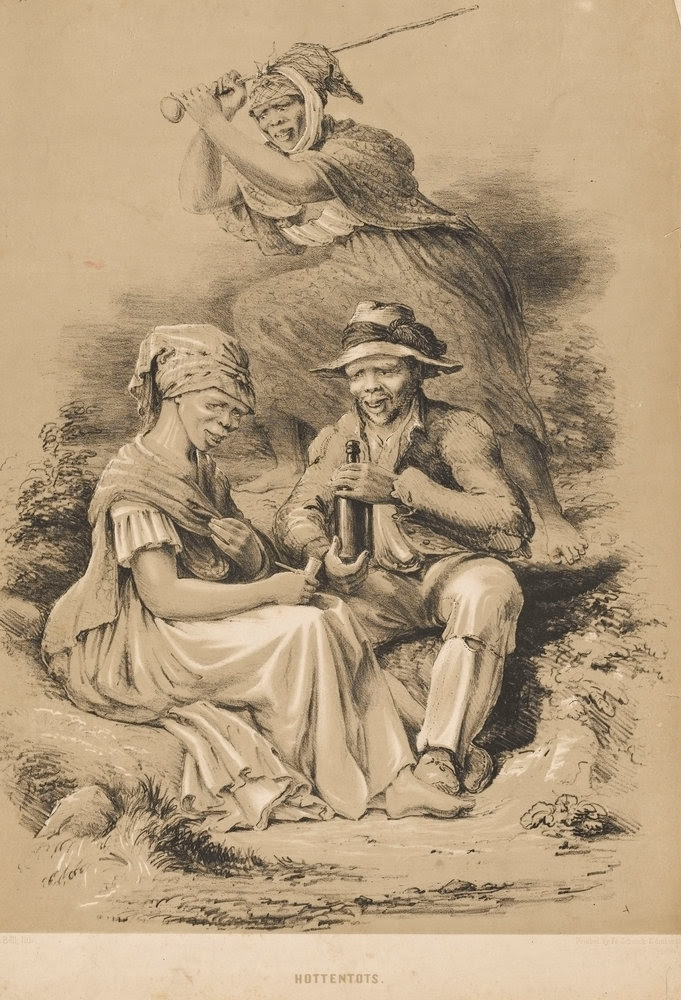Reflection question: "What was life like in South Africa before the arrival of the Dutch? What were the Khoikhoi people like before European contact? What do you think will happen next in this area?"
Source: https://kwekudee-tripdownmemorylane.blogspot.com/2013/06/the-khoikhoi-hottentots-first-people-of.html
THE KHOIKHOI (HOTTENTOTS): THE FIRST PEOPLE OF SOUTH AFRICA
The Khoikhoi or Khoi (called ‘Hottentots’ by early white settlers), are the aboriginal people of South Africa. They are descendants of hunter-gatherers who had become pastoralists and a historical division of the Khoisan ethnic group, the native people of southwestern Africa. The Khoikhoi which means 'real people or men of men" are closely related to the Bushmen (or San, as the Khoikhoi called them).

Khoikhoi tribe man from South Africa
They called Themselves Khoikhoi to distinguish themselves from those who do not own livestock. They had lived in southern Africa since the 5th century AD.When European immigrants colonised the area after 1652, the Khoikhoi were practising extensive pastoral agriculture (meaning they had animals that grazed like cows do) in the Cape region, with large herds of Nguni cattle. The European immigrants labelled them Hottentots, in imitation of the sound of the Khoekhoe language, but this term is today considered derogatory by some.

Khoikhoi girl from Namibia
Archaeological evidence shows that the Khoikhoi entered South Africa from Botswana through two distinct routes – travelling west, skirting the Kalahari to the west coast, then down to the Cape, and travelling south-east out into the Highveld and then southwards to the south coast. Most of the Khoikhoi have largely disappeared as a group, except for the largest group, the Namas. Currently the Nama reside in different parts of Namibia. According to the Namibia Africa Travel and Tourism website, “You’ll find the Nama spread through Namibia; at Sesfontein in Kaokoland, in far south at places like Warmbad, or around Mariental, Tses, Gibeon, Maltahohe, Helmeringhausen and east of Luderitz in the southwestern corner of county.”

Khoikhoi women
The Nama also reside in parts of South Africa, and Botswana.
Jansz boarded a ship on a return voyage to Holland a year later. On board he met Matthys Proot, an army officer, and Jan van Riebeeck, a merchant accused by the VOC of fraud. Proot and Jansz wrote a memorandum, dated 26 July 1649, noting the advantages of establishing a permanent refueling station at the Cape for ships trading with the East. Here, they suggested, fresh produce and water could be acquired to counter the death rate among sailors dying from scurvy and related diseases.

Khoikhoi tribe man from South Africa
They called Themselves Khoikhoi to distinguish themselves from those who do not own livestock. They had lived in southern Africa since the 5th century AD.When European immigrants colonised the area after 1652, the Khoikhoi were practising extensive pastoral agriculture (meaning they had animals that grazed like cows do) in the Cape region, with large herds of Nguni cattle. The European immigrants labelled them Hottentots, in imitation of the sound of the Khoekhoe language, but this term is today considered derogatory by some.

Khoikhoi girl from Namibia
Archaeological evidence shows that the Khoikhoi entered South Africa from Botswana through two distinct routes – travelling west, skirting the Kalahari to the west coast, then down to the Cape, and travelling south-east out into the Highveld and then southwards to the south coast. Most of the Khoikhoi have largely disappeared as a group, except for the largest group, the Namas. Currently the Nama reside in different parts of Namibia. According to the Namibia Africa Travel and Tourism website, “You’ll find the Nama spread through Namibia; at Sesfontein in Kaokoland, in far south at places like Warmbad, or around Mariental, Tses, Gibeon, Maltahohe, Helmeringhausen and east of Luderitz in the southwestern corner of county.”

Khoikhoi women
The Nama also reside in parts of South Africa, and Botswana.
THE DUTCH SETTLEMENT 1652-1795
The grounding of the Dutch East Indiaman, Haerlem, off the Cape coast in 1647 set the stage for things to come. Leendert Jansz and some of the crew were ordered by the commander of the accompanying fleet to salvage what they could and await the fleet’s return.Jansz boarded a ship on a return voyage to Holland a year later. On board he met Matthys Proot, an army officer, and Jan van Riebeeck, a merchant accused by the VOC of fraud. Proot and Jansz wrote a memorandum, dated 26 July 1649, noting the advantages of establishing a permanent refueling station at the Cape for ships trading with the East. Here, they suggested, fresh produce and water could be acquired to counter the death rate among sailors dying from scurvy and related diseases.

Later the Khoi and their animals would cross the mountains leading to the Constantia Valley, then to the Sandvlei/ Muizenberg area and slowly make their way towards Cape Point. When all the grazing on the Cape Peninsula had been exhausted, the people and their flocks would proceed to other parts of the Western Cape.

In the meanwhile as time passed the settlers had slowly become more self supporting with their own small herds of animals. This is when the interests of the two groups clashed. The result was that with less grazing being available, confrontation was inevitable. The Commander at the Cape ordered a wild almond hedge to be planted on the outskirts of the settlement. It would act as a “buffer strip” to keep the different cultural groups apart. As the small settlement extended its range of farming activities, the freedom of the nomadic people to move about as they saw fit, were further disadvantaged.
The Hessequa Khoi lived in the Overberg (over the mountains), moving their herds along the banks of the Breede River. The name Overberg came about when laden ox wagons or those on horse back faced the daunting task of trying to cross the mountains. The area extends from the Hottentots Holland Mountains in the west to Swellendam in the East, the Riviersonderend Mountains in the north and south to the coast – Hermanus, Gansbaai, Cape Agulhas. The Chocoqua clan lived in the Boland (high land) and the Swartland. As time passed the Khoi began to work on farms after finding it more difficult to gain access to grazing land for their herds. The land being controlled by the farmers and or landowners. They were also employed as herd guards, as wagon drivers. Female Khoi were sometimes employed in the homes of whites.

Khoikhoi (Hottentot) women from South Africa, Wooden engraving 19th century
Opposition to their independence and changing lifestyle led to confrontation with the colonists. On 19 May 1659 raids began on the farms of the Cape Peninsula Free Burghers – the First Khoi Khoi Dutch War had begun. But having no fire power/guns, nor the backing of slaves, peace was negotiated with a resultant stalemate. In other words an unsatisfactory draw resulting in neither side being satisfied. This would last for many a long year.
From a Dutch perspective the Cape ‘belonged’ to no one. It was there to be occupied. Van Riebeeck’s diary includes the following brief reference to the native people:
"Others will say that the natives are brutal and cannibals, from whom no good can be expected, and that we will have to be continually on our guard, but this is a vulgar error as will be shown further on. We do not deny that they live without laws or police, like many Indians, nor that some boatmen and soldiers have been killed by them, but the cause is generally not stated by our people in order to excuse themselves. We are quite convinced that the peasants of this country, in case their cattle are shot down or taken away without payment, would not be a hair better than these natives if they had not to fear the law."

Khoikhoi people. By Charles Davidson Bell
Concerned to promote the need for a refreshment station, the memorandum emphasized the friendly
disposition of the native people and their willingness to trade with Dutch ships. The Company officials responded positively to the proposal, while their limited commitment to anything more than a service to passing ships is seen in the decision to send the disgraced van Riebeeck as merchant and head of the project. He was instructed to maintain peaceful relations with both indigenous people and foreign traders who might call at the Cape. These relationships were at the same time bound by a stipulation of the Second Charter of the Netherlands government of 1622, which required the VOC to promote and protect ‘public religion’ - namely, the Reformed orthodoxy of the Dutch Reformed
Church (DRC). The stipulation was a consequence of the Eighty Years’ War between Holland and
Catholic Spain, which ended shortly before the Dutch occupation of the Cape.19 Described as “a
struggle in which church and people were thrown together in one mighty exertion of power,” it laid
the foundation for religio-political Dutch imperialism.

Khoikhoi (Hottentots) cook around a forage pot near B
No comments:
Post a Comment